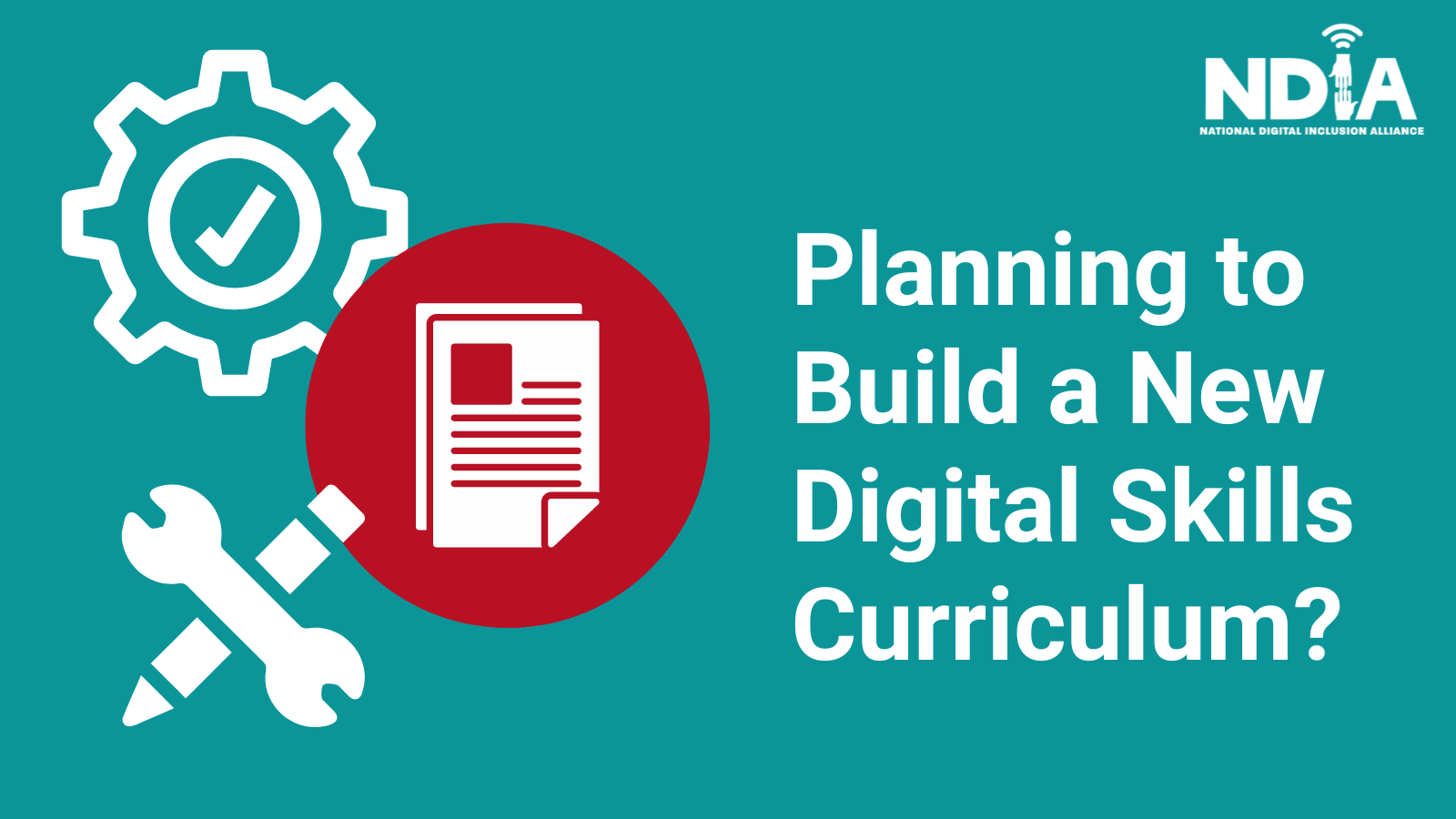
Supporting digital skills building is a complicated aspect of digital inclusion work. Each community and each individual requires a different level of support, with different needs and desires when it comes to digital skills building.
Luckily, there is no need to build an entire curriculum or even lessons entirely from scratch. Seasoned digital inclusion practitioners have constructed hundreds of shared lessons, lesson plans, and digital skills frameworks.
When planning a digital skills program, work with your community of learners to determine what they would like to focus on, and ensure these are prioritized within your framework.
Planning your curriculum can be as simple as building or adapting a framework, identifying gaps in available resources, and finding ways to fill them, whether that is seeking out a specific resource, or developing it yourself.
Digital Skills Frameworks – Where to Start
A digital skills framework is a guiding document that determines the direction, audience, and focus of a digital skills program. A framework can help to define fundamentals and to incorporate culturally relevant digital skills. It lies somewhere between a map and a checklist for developing digital literacy within the expected audience.
The Digital Resilience in the American Workforce has compiled a series of briefs to help navigate many digital skills frameworks created by local governments and organizations. Learn more here – Putting Digital Literacy and Digital Resilience into Frame.
When developing your own digital skills framework for your community, ensure that it includes some social, entertainment, and communication skills, not just the skills required to engage in the workforce. Listen to the needs and desires of your community, and ensure that your framework reflects their interests.
In addition to conversations, we can learn a lot about our community needs through data.
The National Governors Association published Using Data To Advance Digital Skills: A State Playbook to assist in guiding your approach to building a digital skills framework and digital literacy strategy.
Use Existing Resources
Lessons and tutorials on digital skills topics are available for free online through a variety of different programs! Below is a chart of resources we recommend to our community. We’ve annotated them to include languages and whether there is support for facilitators to utilize these resources.
| Program | Creator | Languages | Special Features | Facilitator Support |
|---|---|---|---|---|
| DigitalLearn | Public Library Association | English | Provides templates for instructors to build their own courses | Yes |
| GCFGlobal | Goodwill Foundation | English, Spanish, Portugues | Yes | |
| Digital Literacy Pathway | WebJunction | English | Provides guidance for instructors on how to evaluate and engage with digital literacy skills resources and programming | Yes |
| TechBoomers | TechBoomers | English | Offers a WIDE variety of topics in listicle lessons and video tutorials, much like an early Buzzfeed format. Great for community members looking to answer their own questions. | No |
| Applied Digital Skills | English, Spanish, French | Offers both a robust curriculum, but also extensive materials for learning to teach digital skills | Yes | |
| Grow with Google | English, Spanish, French | Brings Google resources to organizations and provides career-focused certifications | No | |
| Senior Planet | Older Adults Technology Services (OATS) by AARP | English, Spanish | Live, synchronous classes for community members 60+ | No |
| Web Literacy | Mozilla Foundation | English | Offers lesson plans called “playlists,” including offline activities and online instruction | Yes |
| Microsoft Learn | Microsoft | English | Presents trainings on Microsoft products with clear prerequisites. Instructor materials focus on building skills as a trainer. | Yes |
Digital Skills Library – This aggregate library of digital skills serves as an excellent example of how to align lessons and methods from a variety of resources to create a comprehensive digital skills curriculum, and is available for community use! It was constructed to follow the Seattle Digital Equity Initiative’s Digital Skills Framework. Many thanks to World Education for this invaluable resource.
The Digital Skills Library offers a variety of types of content, including audio, video, activities, articles, and assessments. Many of these represent the resources listed above but also include a wider range of topics and content that may be relevant to specific community wants and needs.
Northstar Digital Literacy was developed by Literacy Minnesota in an effort to fill a unique niche: digital literacy skills assessments complete with certificates of achievement. The program, now also available in Spanish, provides targeted learning opportunities to help users build skills and address deficits identified in their assessments.
Paid subscriptions to Northstar Digital allow organizations to track the growth of digital skills in their community, identify areas of need and strength, and proctor digital skills assessments, as well as engage in training for staff members to increase impact.
Planning for the Future
As we’re planning for a new influx of digital inclusion dollars, it is important to ensure we can reach as many communities as possible without duplicating efforts and services. Rather than investing funds into building new digital skills training materials, consider where you can lean on your fellow digital inclusion community members and utilize and modify existing resources to meet your needs.
If you’re having trouble finding material on specific subject areas or instruction methods, you may not be the first or only one. If you are looking for a particular resource and cannot find it, ask the NDIA community! The NDIA listserv is a great resource to access community knowledge, and other opportunities like working groups offer chances to dig deeper into resources and connect more with other members.
Partnering with communities with similar demographics across your region, or across the country can be beneficial not just for the organizations directly involved, but also for the great digital inclusion community.
